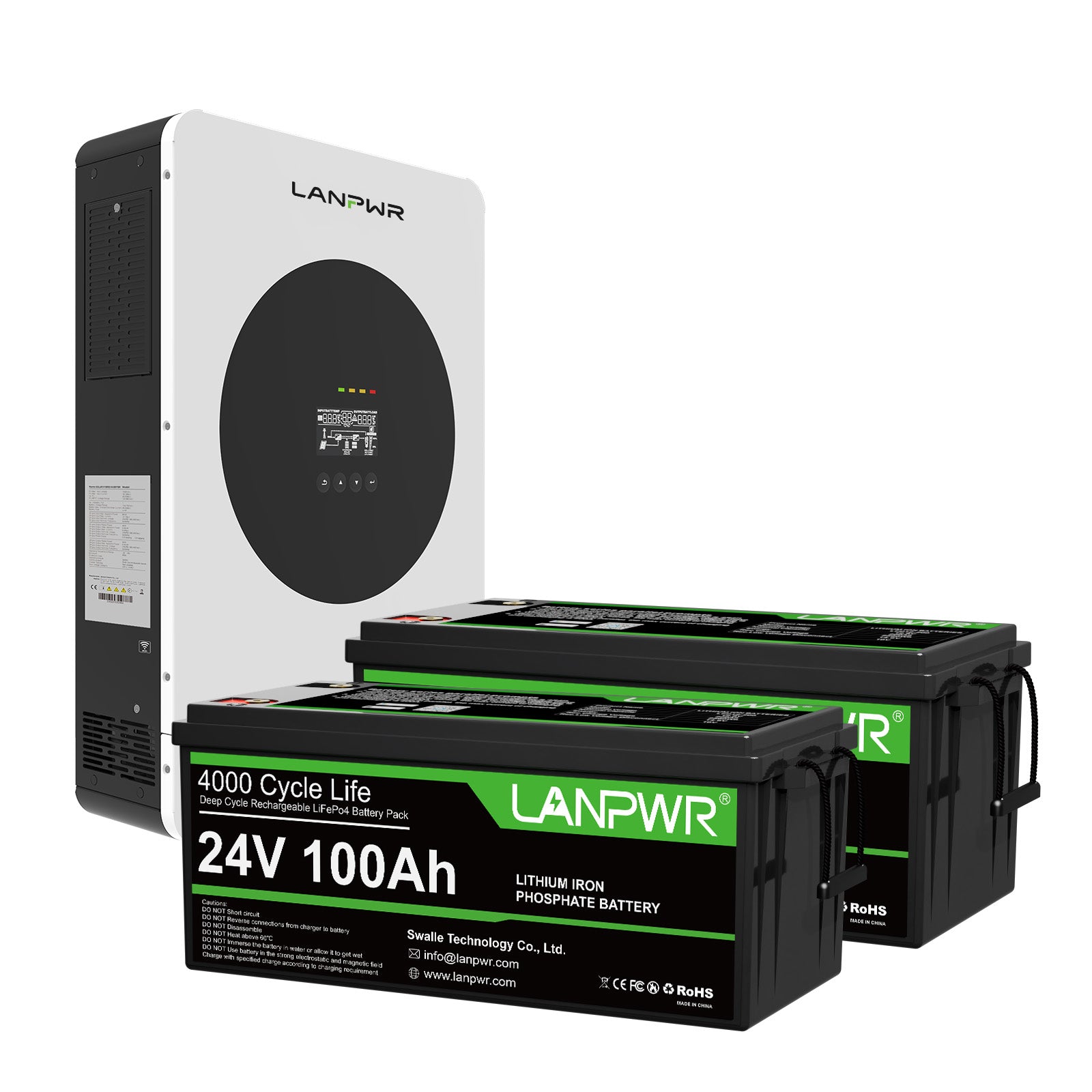
ALT: LANPWR D5-2500 portable power station.
One of the primary concerns somebody should always have about portable power stations is how long their lifespan should be expected to remain intact. Portable power stations offer reliable electricity access for various electronic devices, but how long is the lifespan expected to extend?
A portable power station's lifespan depends heavily on its battery type and quality components. Lithium-ion batteries typically offer 500 to 1000 charge cycles before their capacity drops by approximately 20%. With daily charging/discharging cycles, this would translate to approximately two or three years with light use, though with moderate usage, many users experience much greater longevity with their station.
Factors Affecting Portable Power Station Lifespans
Portable power stations' lifespans depend upon various vital variables influencing them; understanding these can help maximize efficiency and lifespan for maximum device use. Here are the primary considerations that affect lifespan:
- Battery Type and Quality
Battery types and qualities can have a major influence on portable power stations' operation. Lithium-ion batteries are often favored due to their high energy density and long cycle life. Higher-quality batteries equipped with advanced management systems may offer additional protection by more effectively controlling charge levels and temperatures, thus prolonging unit longevity.
- Charge and Discharge Cycles
It is of crucial importance that portable power stations can handle numerous charge/discharge cycles before their battery capacity significantly degrades, Typically, a LiFePO4 battery retains about 80% to 90% of its original capacity after 500 to 1000 charge cycles. This capacity retention rate makes them an excellent choice for applications requiring a long service life and high cycle count, such as electric vehicles, solar energy storage, and portable power stations.
- Usage Frequency
Frequent usage of a portable power station puts additional strain on its batteries. Repeated deep discharges followed by full recharges can accelerate battery aging; conversely, infrequent usage without proper periodic charging can have detrimental impacts due to underutilization. 
- Environmental Conditions
Temperature plays a pivotal role in ensuring portable power stations function at peak capacity and efficiency, from shortening battery efficiency temporarily through permanent cell damage caused by excessive heat exposure to corrosion of electrical components, thereby shortening device lifespan even further.
- Storage Conditions
How and where a portable power station is stored when not significantly used affects its longevity. Prolonged full discharge or full charge storage conditions are detrimental to battery health; in contrast, optimal conditions would include 50-60% charge level storage in an ideal climate with cooling conditions for battery protection.
- Maintenance and Care
Regular care can significantly extend the lifespan of portable power stations. This involves removing dust from vents, keeping it dry, and avoiding shocks that might damage internal components.
- Charge Management
Proper charge management is vital to prolonging the battery's lifespan in any power station, from avoiding overcharging to keeping its charge from depleting entirely. Many modern power stations come equipped with specific mechanisms to monitor this aspect; nonetheless, user vigilance remains necessary in some instances.
- Condition and Quality of Connected Devices
The condition and quality of devices connected to a power station can significantly shorten its lifespan. Overloading its capacity by connecting devices that draw too much power or cause power surges will eventually damage batteries and internal components, degrading their condition over time and shortening their lifecycle.
Tips to Extend the Lifespan OF Portable Power Station
Extending the lifespan of portable power stations involves proper usage and maintenance practices. Here are a few valuable suggestions that may help ensure maximum benefit over its operational lifetime:
- Maintain Optimal
Charge Levels To extend the battery's lifespan and preserve optimal charge levels on a portable power station battery, keep its charge between 20%-80% rather than completely discharging it occasionally. Doing this could stress and shorten its lifecycle significantly.
- Establish Proper Charging Practices
Do not overcharge the power station; modern units have built-in protection against this. Nevertheless, once fully charged, unplug the station once unplugged from the power supply, as this charger was explicitly designed to deliver optimal charge rates and voltages for your device. 
- Place Your Portable Power Station in a Cool, Dry Space
Extreme temperatures can have severe ramifications for battery performance and lifespan. While high temperatures may speed up the degradation process of cells faster than usual, cold temperatures could temporarily reduce efficiency, reducing charging capacity. Both factors require safeguarding over time to remain effective for the longevity of portable power stations' performance. Storing them properly helps sustain their integrity over time.
- Periodically Recharge When in Storage
To keep the power station functioning at peak performance for as long as possible, one must store it carefully. Lithium-ion batteries' ideal storage charge level should be between 50%-75% to protect their health. It is also wise to top off with extra juice every three to six months to prevent its discharge levels from falling too low and becoming harmfully discharged.
- Use a Protective Case
Physical protection for your portable power station can significantly extend its life. Installing a protective case protects it against mechanical damage caused by falls or impacts and environmental factors like dust and moisture accumulation.
- Keep It Clean
The device must remain free from dust and debris that could block vents, leading to overheating and potential issues. Use a soft cloth to wipe down its exterior and clear any vents or fans; harsh chemicals or water could seep into its inner workings and cause irreparable damage.
- Assess Device Health
It's advisable to keep tabs on how the power station performs over time. Keep an eye out for sudden drops in efficiency or charging issues that indicate potential trouble spots that could require early diagnosis for optimal operation and longevity. Detection will prevent further damage while prolonging the lifespan.
- Update Firmware
Portable power stations feature Firmware that helps manage their operation. Manufacturers frequently release updates to this Firmware to enhance performance and prolong battery life; keep up to date with your device's Firmware to guarantee efficient device functioning.
- Limit Exposure to Extreme Conditions
When placing the power station outdoors, keep it away from direct sunlight for extended periods and do not expose it to wet environments unless listed explicitly as waterproof - taking these precautions can help preserve its overall durability and reduce wear-and-tear issues. This helps ensure environmental wear-and-tear is minimized.
Signs Your Portable Power Station Needs Replacing
Recognizing when it is time for you to purchase a replacement device is critical in maintaining reliable access to power when needed most. Here are key signs that it might be time for an upgrade:
- Degraded Battery Capacity
Over time, batteries become degraded and hold less charge. Still, if your power station's capacity to charge devices has significantly declined over time, it has reached the end of its usable lifespan and requires replacing or updating entirely. For example, if devices run out of juice quickly under constant load conditions, this could indicate battery replacement is imminent or that additional units need purchasing as replacements for current devices may also need upgrading/replacing altogether.
- Increased Charge Times
If your portable power station takes considerably longer to charge than it used to, this could indicate battery degradation. Batteries that have lost efficiency often need longer to fully charge due to decreased electrical conductivity and increased internal resistance resulting from decreased electrical conductivity or internal resistance issues.
- Physical Damage
Signs of wear and tear, such as dents or cracks, may indicate internal components needing repair at your power plant. In contrast, severe issues like swelling battery capacity or signs of leakage should serve as red flags for potential physical damage that reduces efficiency while potentially increasing safety risks. Such physical damage diminishes efficiency and can pose safety threats that diminish efficiency over time.
- Unreliable Output
If the power station becomes inconsistent in providing electricity to devices it once powered easily or unexpectedly shuts off without warning, this may indicate internal electronic problems or battery degradation. Frequent interruptions during usage indicate it might no longer be reliable.
- Frequent Overheating
Electric power stations generate heat while in operation; however, excessive heating should be of concern. If the device becomes too hot to touch during regular usage or frequently overheats during its average run-time, this could indicate internal damage or malfunction, and it might be safer and more economical to replace it than keep running it for a prolonged period.
- Noisy Operation
Most power stations contain built-in fans to cool their internal components, so when one becomes unusually loud or you hear unfamiliar noises during operation, it could indicate internal problems that could quickly lead to the failure of this facility.
- Obsolete Technology
Technology changes exponentially, and more modern models often offer superior efficiency, higher capacity, lighter weight, and enhanced features than older ones. If your power station is several years old, upgrading may provide improved performance and additional benefits that match your requirements.
- Error Indicators
Many modern portable power stations feature LED indicators or LCDs with error codes displayed as error messages or codes. If your device frequently shows these, refer to its manual for interpretation if persistent error codes continue to display on it. Constant error codes could signal replacement needs.














Leave a comment
This site is protected by hCaptcha and the hCaptcha Privacy Policy and Terms of Service apply.